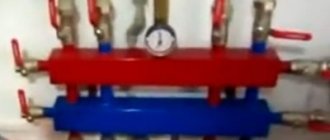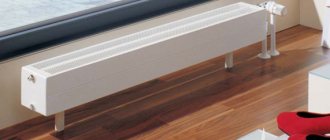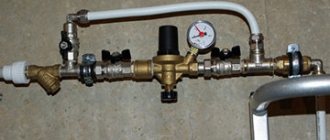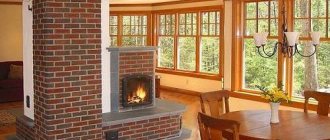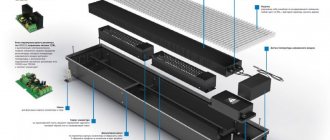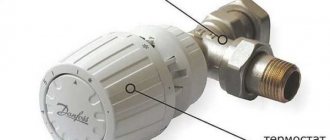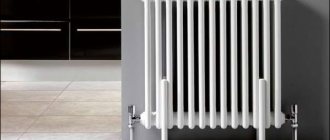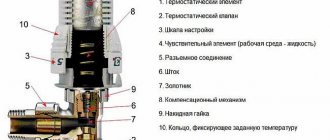Autonomous heating systems can be built in different ways. One of the most popular types of heating systems in the home is the liquid-cooled design. Usually, water with special additives is used as it.
Heating distribution manifold
Such a system may have several heating circuits, for example, heating through radiators and through heated floors. In order for the water to be distributed evenly in such a system, a distribution heating manifold is needed.
Why do you need a collector, principle of operation
The design of this plumbing fixture is very simple. Essentially, this is a piece of large diameter pipe equipped with threaded fittings for connecting the circuits of the water system. The length of the heating comb depends on the number of connections; the main line is usually connected to the end.
Reference. As a rule, collectors are equipped with outlet pipes of the same diameter, which is 0.5...0.75 from the cross-section of the main chamber. The distance between the fittings varies depending on the coolant flow in the circuits and the purpose of the comb.
What happens in the collector, where water flows from 2...10 parallel branches:
- From several lines, a coolant with various parameters - temperature, flow rate, flow rate per unit of time - enters the collection pipeline.
- In a large flow section of the comb, the speed of water movement decreases and the hydraulic resistance decreases.
- Mixing in the main chamber, different flows acquire the same temperature and speed at the outlet.
Scheme of operation of a collector pipe for collecting coolant
So, the task of the collector is to collect coolant, equalize its parameters and send it back to the boiler along the main line. You cannot do without a comb when you need to combine several lines with different water flow rates, hydraulic resistance and length into one pipeline. Try to connect such branches on tees - 2-3 circuits will immediately stop working normally.
The heating distribution manifold operates in a similar way, only in the opposite direction. Water from the boiler, flowing slowly through the main chamber, is distributed in the required quantity through secondary lines.
One bare pipe with branches is of little use without accompanying fittings - taps, valves and other elements. The assembled collector unit helps solve several important problems:
- regulate the amount of coolant in each branch, balance them among themselves;
- by mixing, reduce the temperature of the supplied water and maintain it at a given level;
- empty the system, bleed air;
- automatically control the microclimate of each room using room thermostats.
How to install?
Before installing a water distribution unit for cold and hot water supply, give an accurate answer to the following questions and consider the following points:
- How many water consumers are there on site? The number of collector outlets should be the same or slightly greater than the number of consumers. Excess branches are closed with plugs.
- What type of pipes will be used to install the water supply? It is necessary to purchase devices designed specifically for pipes made of the selected material.
- Estimate in advance the position of all engineering elements in the space of the plumbing cabinet (you can make markings on the wall). Please note that a water meter and a water filter are installed in front of the distribution comb. The convenient location of all devices facilitates maintenance and repair work.
- Get reliable fastening - a poorly secured distribution unit can lead to depressurization of connections and damage to the pipeline.
- Before installation, make sure that you have all the necessary consumables on hand: sealing material, gaskets, adapters.
Installation of the water distribution unit occurs in the following sequence:
- Install the inlet shut-off valves on the water supply riser.
- Install the meter, filter and check valve.
- Connect the manifold and securely fix it to the wall
- Install a water supply to each consumer. Secure the pipes with fasteners.
This operating algorithm will allow you to avoid errors. Regardless of whether the collector is needed for water supply or heating, its installation is the same. Such wiring requires more time, skill and money, but pays off quickly and provides comfort in further use. Collectors are appropriate not only in cottages and large houses, but also in apartments.
Types of collector units
Before considering the types of combs, we will indicate ways of their use in water heating systems of private houses and apartments:
- distribution and regulation of water temperature in underfloor heating circuits, abbreviated as TP;
- distribution of coolant to radiators using a radial (collector) circuit;
- general heat distribution in a large residential building with a complex heat supply system.
On the left in the photo is a coplanar manifold for distributing the coolant among the branches, on the right is a ready-made collector module with a hydraulic switch.
In country cottages with branched heating, the collector group includes a so-called hydraulic switch (otherwise known as a thermo-hydraulic separator). Essentially, this is a vertical manifold with 6 terminals: 2 from the boiler, two to the comb, one on the top to remove air, and water is discharged from the bottom.
Addition. There are cascade water guns with a large number of fittings where the heating circuits are connected directly. Then the manifold type distributor is not used.
Now about the types of distribution combs:
- To limit water temperature, regulate flow and balance heating floor circuits, special collector blocks made of brass, stainless steel or plastic are used. The size of the connecting hole of the main heating main (at the end of the pipe) is ¾ or 1 inch (DN 20–25), the branches are ½ or ¾, respectively (DN 15–20).
- In radiator beam circuits, the same combs of underfloor heating systems are used, but with reduced functionality. We will explain the difference below.
- For general house distribution of coolant, large steel collectors are used, the connection diameter is over 1” (DN 25).
Factory manifold groups are not cheap. To save money, homeowners often use hand-soldered polypropylene combs or buy cheap distributors for water supply systems. Next we will indicate the problems associated with the installation of homemade and plumbing manifolds.
Combs for radiator and floor systems – made of stainless steel, brass and plastic
Advantages
The collector method has its fans both among professionals and among ordinary people.
This is due to the positive features that this heating method guarantees.
- Heat is distributed evenly. A priori, it is assumed that the temperature entering the pipes from the collector does not drop. In this regard, uniform heating and temperature maintenance is achieved in all devices connected to the system. At the same time, there is always the opportunity to lower the temperature if necessary.
- Possibility of customization. If desired, you can not only regulate the temperature, but also completely turn off any of the branches. For example, if heating is not needed in one of the rooms, you can simply turn off the radiator, thereby preventing idle heat release. This is especially convenient if you live in a large house, for example, a 3-story mansion, and do not always use all the rooms. Adjustment is carried out from the manifold cabinet.
- Easy to repair. If any part of the system breaks, you do not have to turn off the entire system (we are not talking about the breakdown of the collector itself). It will be enough to shut off the heat supply to the damaged branch.
- Aesthetic appeal. By connecting the collector, you get the opportunity to place the pipes anywhere, not just above the radiator. Many take advantage of this circumstance and make the pipes hidden, hiding them under the baseboard or behind a false wall.
Comb device for heated floors
The temperature of the coolant supplied to the underfloor heating circuits should not exceed 50 °C, the optimal temperature schedule is 40/30 °C. If the floor surface heats up above 30 degrees, the room will become stuffy and uncomfortable.
Only gas boilers are capable of maintaining a supply of 40–50 °C, and even then with a loss of efficiency. To effectively consume gas or other energy carriers, water must be heated to 60 degrees, and then the temperature at the entrance to the transformer loops must be reduced. This is one of the main tasks of the collector block, consisting of the following elements:
- the collector itself – 2 separate tubes (supply and return) with wall mounting brackets;
- thermostatic pressure valves with connection for Eurocone pipes;
- flow meters (rotameters) with a scale of 0.5…5 l/min;
- end blocks with automatic air valves and drain valves;
- dial thermometer blocks;
- shut-off ball valves;
- bypass line with bypass valve.
Distributor design for underfloor heating systems
Rotameters and pressure valves are screwed into special sockets on the comb, the latter are closed with plastic caps. Air vents with drain valves are screwed into the ends of the collector tubes on one side, and blocks of thermometers and taps on the other. The bypass is installed depending on the design of the comb.
Note. Typically, flow meters are located on the supply line, thermal valves are on the “return” line. But there are also other models of collectors with rotameters on the return line. If you mix up the distributor tubes, you won’t be able to twist the valves instead of the flow meters - the internal shape of the bushings is different.
The thermometers are followed by ball valves, followed by a circulation pump and a mixing unit. Let's consider each element of the collector group separately.
Design and purpose of flow meters
Rotameters are designed to monitor and regulate the maximum fluid flow through loops. The elements are screwed into special pipes on the manifold without winding materials - the seal is an EPDM rubber gasket.
The flow meter body contains a spring-loaded rod with a working plate at one end and a control washer at the other. How does a rotameter work:
- The coolant flows through the side hole in the housing, then moves down, presses on the plate and goes into the pipe.
To adjust the maximum flow on the flow meter using the adjusting washer, you need to remove the protective plastic cap - The more water flows through the flow meter, the greater the pressure on the plate. The spring is compressed, the rod with the control washer is lowered. The flow rate in l/min can be observed on the scale marked on the transparent bulb of the element.
- The amount of flow is regulated by rotating the upper part of the housing. When twisting, the passage hole is partially or completely closed by the piston.
Reference. Some manufacturers' collectors are equipped with unregulated rotameters. To limit flow, separate valves built into the pipe body are used. See the video below to see how such elements look.
Flow meters installed on the return line are designed similarly, only the spring is on the other side of the control washer. The coolant enters from below and pushes the plate upward, the rod and washer rise. How to distinguish between different types of rotameters:
- if, in the absence of flow, the washer is at the top of the flask, then the flow meter is placed on the supply;
- if at zero water flow the washer is at the bottom of the scale, the element is intended for “return”;
- the scale on the flask is graduated in the appropriate direction, in the first case the counting is from top to bottom, in the second – from bottom to top.
During operation, rotameters must be maintained - cleaned when dirty. A transparent bulb serves as an indicator; when it becomes coated from the inside, the element should be unscrewed, disassembled and dirt removed from the working surfaces.
How does a thermostatic valve work?
Structurally, the product is no different from other similar thermal valves - radiator or two-way. When you press the spring-loaded rod, the plate lowers into the seat, blocking the passage of the coolant. It is possible to preset: the maximum flow rate is limited by rotating the valve core using a hex key.
Clarification. There are 2 types of valves - normally open and normally closed. The first ones are described above - when you press the rod, the passage closes. The latter are used less frequently, where the channel is initially closed, and when the rod is lowered, the hole opens.
The purpose of the thermostatic valve is to regulate coolant flow during operation (not balancing!). Management is implemented in 3 ways:
- Manual. The position of the rod is adjusted by a plastic handle, which is screwed onto the valve from above.
- Automatic RTL thermal heads that press the rod when the return flow temperature increases. Do not confuse them with conventional radiator heads that respond to air temperature.
- Electric servos connected to room thermostats or weather-dependent automation.
Manual control requires constant attention from the user - when the ambient temperature changes, you will have to press or release the rod. Thermal heads of the RTL type automate the process, but work well only on short loops - up to 60 m. Servo drives plus thermostats are applicable everywhere.
Other comb accessories
At the beginning of the publication, we listed the tasks that the underfloor heating collector group must solve. With balancing and flow control it is clear - these functions are performed by rotameters and valves. Let's move on to the remaining accessories:
- Terminal unit for emptying and automatically removing air bubbles. The element consists of a housing with a drain valve and a float air vent. The fitting is closed with a plug, which at the same time serves as a thumb for opening the valve.
- Blocks of dial thermometers marked up to 80–90 °C. The purpose is clear - measuring the temperature at the inlet and outlet of the comb.
- Ball shut-off valves. Depending on the method of connecting the collector to the heating, straight, angular, American and internal/external threaded taps are used.
- A bypass jumper with a bypass valve is used in systems with automatic control. If, due to warm weather, all circuits are closed, the coolant will flow through the bypass in a circle, the pump will not work on its own. In normal mode, the valve will not allow water to circulate directly and will force it to move in loops.
From left to right: drain end fitting with manual air valve, block with automatic air vent, ball valves and thermometers
Note. Through the terminal unit, you can not only drain the coolant, but also pump it in in case of repairs. The collector is cut off from the main line by taps, and the TP circuits are emptied or recharged through a side fitting.
The number and variety of additional fittings depends on the comb manufacturer. These accessories are the main ones; in addition to them, various plugs, adapters and valves are also used.
A mixing unit is located in front of the collector block; its composition depends on the method of preparing the coolant for the TP. There are 3 methods of bringing water in heated floors to the desired temperature:
- Mixing into hot water circuits with a two-way thermostatic valve. The element launches portions of the coolant at the command of a thermal head with an external temperature sensor in the form of a copper flask. The latter is attached to the metal wall of the manifold and connected to the head through a capillary tube.
- Mixing cooled and heated coolant using a three-way valve. The principle is as follows: the pump drives water through the bypass along the circuits; when it does not cool down, the valve opens the supply of heated water from the boiler line. The difference from the previous method is a smoother flow and mixing quality.
- Restriction of reverse flow by RTL thermal heads installed on the comb thermal valves. Here a pump module is not needed at all.
You can control a two- or three-way valve in three ways: manually, using a thermal head with a remote flask and an electric actuator. The latter is controlled by a controller that receives signals from room or weather sensors.
Hydraulic boom and its function
This is a fairly simple device. It can be made from a piece of pipe with a cross-section three times larger than the boiler outlet pipe. It is necessary to weld curved plugs onto the ends of the segment. The plugs are then tapped with threaded holes. They will serve to vent air or drain water. We drill holes in the body of the pipe, in which we also cut threads. We will connect the boiler outlet pipe and heating circuits to them. The body of the hydraulic arrow must then be sanded and painted.
hydraulic arrow
Distributor for radiant heating system
Let us remind you: radial wiring provides for an individual two-pipe connection of each radiator to a common distribution manifold located in a convenient location (usually closer to the center of the building).
An example of radiant heating distribution in a one-story house
To install the collector unit, the following combs are used:
- factory for TP (described above), made of stainless steel, brass or plastic;
- factory for water supply with built-in shut-off valves, made of polypropylene or metal;
- homemade manifolds twisted from brass fittings and polypropylene tees.
The type of comb you choose depends on your budget and radiator system requirements. If each battery is equipped with its own balancing valve and thermal head, then a clean manifold without valves and flow meters is sufficient. Leave the air and water discharge module.
Advice. If you have a limited budget, you can choose an inexpensive water supply manifold with taps, shown in the photo. Many homeowners do this and balance the system with radiator valves.
If you want to automate the heating operation and place all adjustments in a manifold cabinet, buy a comb for underfloor heating. Install all accessories - rotameters, valves with servo drives, air vents, room regulators. A mixer is still not needed; the coolant is supplied to the batteries directly from the boiler room.
The video below shows a combined heating manifold that distributes heat to radiator wiring and floor circuits. Both parts of the comb are installed in parallel. Please note that the master used water distributors to distribute the coolant.
Modifications of distribution combs
Today there are many types of collector devices designed for heating systems on the market. You can find conventional connecting links that do not have auxiliary shut-off valves. There are also complex blocks with many additional elements.
The simplest devices are made of brass and have inch holes. On the reverse side they have plugs that can be used to expand the system and add additional secondary devices.
Mechanisms with a more complex design have components that are equipped with ball valves. Shut-off valves are installed on each outlet element. More expensive devices may have:
- Flow meters. They are necessary to regulate the flow of coolant for each individual loop.
- Electronic valves. Their purpose is to maintain the required temperature.
- Thermal sensors.
- Valves for automatic removal of air from the system.
The number of circuits can vary from 2 to 10. It all depends on the consumers. Intermediate manifolds can be made of brass, stainless steel, polypropylene. Most often they choose polypropylene, as they are the cheapest.
Common house collector group
The main comb performs the same functions as the TP collector - it distributes the coolant among the branches of the heating network of various loads and lengths. The element is made of steel - stainless or black, the profile of the main chamber is round or square.
Reference. Factory-made main manifolds are called coplanar. This buzzword means that all the parts of the comb lie in the same plane - the vertical supply pipes completely intersect the “return” chamber and vice versa. The goal is to reduce the weight and dimensions of the structure.
There are compact models of distributors for 3–5 circuits, made in the form of one pipe. Here's the trick: the return manifold is placed inside the feed chamber. As a result, we get 1 common housing with 2 cameras of equal capacity.
In the vast majority of country houses with an area of up to 300 m², distribution manifolds are not needed. For several heat consumers, a piping scheme using the primary-secondary ring method is used, described in a separate article. When should you think about buying a communal heating comb:
- the number of floors of the cottage is at least two, the total area is over 300 square meters;
- for heating, at least 2 heat sources are used - gas, solid fuel, electric, and so on;
- the number of individual radiator heating branches is 3 or more;
- The boiler room diagram contains an indirect heating boiler, heating circuits for auxiliary buildings, and heating of the pool.
The listed factors must be considered separately and together, and to select a model of specific sizes, the load on each branch must be calculated. Hence the conclusion: it is better not to buy a collector without consulting an expert.
Drawing of a coplanar manifold and photo of the finished product with pumping groups
The most popular models
1. Oventrop Multidis SF.
An inch heating comb is designed to organize heating with a water heated floor. Made from tool steel, characterized by high wear resistance. Main characteristics:
- permissible pressure in the circuit – 6 bar;
- coolant temperature – +70 °C.
The series is produced with valve inserts M30x1.5, and can also be equipped with a flow meter for connecting circuits located in different rooms. A bonus from the manufacturer - soundproofed mounting clamps. The number of simultaneously serviced branches is from 2 to 12. The price, accordingly, is 5650-18800 rubles.
To work with high-temperature appliances, Oventrop suggests using a heating system distribution manifold made of Multidis SH stainless steel with a Mayevsky tap. The design can already withstand 10 bar at +95-100 °C, the comb throughput is 1-4 l/min. However, products with 2 circuits have slightly weaker performance. The cost of Oventrop SH hydraulic valves ranges from 2780-9980 rubles.
Plumbers: You'll pay up to 50% LESS on your water bills with this faucet attachment
- HKV – brass underfloor heating manifold. Maintains a pressure of 6 bar in the range of +80-95 °C. Rehau version D is additionally equipped with a rotameter and a tap for filling the system.
- HLV is a heating distribution comb designed for radiators, although its characteristics are identical to the description of HKV. The only difference is in the configuration: a Eurocone is already provided here and the possibility of a threaded clamp connection with pipes.
The manufacturer Rehau also offers to buy separate Rautitan combs with three outlets for pipeline installation using sliding sleeves.
Heating distribution manifold made of steel with anti-corrosion coating. It operates in systems with temperatures up to +110 °C at a pressure of 6 bar and is hidden in a special heat-insulating casing. The throughput of the comb channels is 3 m3/h. Here the choice of designs is not very rich: it is possible to connect only from 3 to 7 circuits. The cost of such hydraulic valves will range from 15,340 to 252,650 rubles.
Stainless steel manifolds are produced in an even more modest range - for 2 or 3 circuits. With the same characteristics, they can be purchased for 19,670-24,940 rubles. The most functional Meibes line is the RW series, which already comes complete with various connecting elements, thermostats and manual valves.
- F – a flow meter is built into the supply;
- BV – has quarter taps;
- C – provides for extension of the comb through a nipple connection.
Each Danfoss heating manifold allows a system pressure of 10 atm at an optimal temperature (+90 °C). The design of the brackets is interesting - they fix paired combs with a slight offset relative to each other for more convenient maintenance. Moreover, all valves are equipped with plastic heads with marked markings, which allows you to set their position manually without the use of tools. The price of Danfoss models, depending on the number of connected circuits and additional options, varies between 5170 - 31,390.
The heating manifold can be selected for a Eurocone with 1/2″ or 3/4″ outlets or with a metric threaded connection. Far combs can withstand pressure up to 10 atm at temperatures not exceeding +100 °C. But the number of outlet pipes is small: from 2 to 4, but the price is the lowest of all the products reviewed in our review (730-1700 rubles for an unpaired distributor).
Tips for choosing
Despite the apparent simplicity of the combs, they need to be selected based on several technical parameters:
1. Pressure in the system - this value determines what material the distribution manifold can be made from.
2. The throughput must be sufficient so that the connected heating circuits do not “starve” from a lack of coolant.
3. Energy consumption of the mixing unit - as a rule, it is determined by the total power of the circulation pumps.
4
Possibility of adding circuits - this parameter should be paid attention only when in the future it is planned to build additional objects that require heating
The number of pipes on the hydraulic distributor must correspond to the number of connected branches (heating devices). In some cases, it is better to install several collectors, for example, in a two-story house - one block on each level. It is also possible to install unpaired combs at different points: one on the supply, the other on the return.
Finally, experts and experienced installers in their reviews advise not to skimp on buying a good collector. In order for it to serve for a long time and not cause any problems, the name on the box must be known.
Installation nuances
The technology for attaching the collector to the wall is quite simple: the TC and radial distribution comb are suspended on mounting brackets, the loops are connected with Eurocone fittings. Pipes going to the top of the collector (usually the “return”) are passed under the bottom.
Advice. No one is forcing you to mount the distributor on brackets. If necessary, the tubes can be spread apart and mounted separately on the wall. The collector box is used in residential areas; when installing the collector in the boiler room, the cabinet is not needed.
Let's briefly list the main points:
- The size of the comb is selected according to the diameter of the pipes used in the heating loops - Ø16 or Ø20 mm. Accordingly, we take a ¾ or 1 inch distributor. The material of the product does not matter; in terms of price/quality ratio, stainless steel wins.
- If the number of comb outlets exceeds 12, assemble a collector assembly of 2 sections. When installing accessories, winding materials are not used, since the parts are equipped with rubber seals.
- A heavier common house collector is suspended on hooks, reinforced brackets, or installed on the floor. Pumps, pipes and other piping elements must not load the distributor with their own weight.
- The hottest coolant receives an indirect heating boiler. The coil and circulation pump of the water heater are connected to the comb directly, usually from the end.
- The radiator heating and TP branches are connected to the manifold through mixing units with three-way valves. A separate pump is installed on each line, selected for pressure and performance.
A heavy coplanar comb can be installed on the floor - weld metal supports
Important point. The mixing unit for heated floors can be installed in the boiler room, near the main comb. Then water at the required temperature will flow to the TP distributor.
What to pay attention to
Any solar installation is characterized by a rated power, which is indicated in kilowatts. This is the amount of energy that is generated when the sun is bright at its zenith. This means that the system's efficiency will decrease in the morning and evening. At night, most likely, it will be possible to use hot water only from the boiler, where water has accumulated throughout the day.
When choosing a collector model, pay attention to whether it can be used in winter. And what power should the system to which the collector is connected have?
The installation of collectors is usually carried out on the roof or on a frame, which is mounted separately.
Finally about homemade collectors
Above in the text we mentioned budget options for combs - tap, polypropylene and homemade. Such distributors can be used without problems in radiator beam circuits. To balance and regulate the flow, a balance valve and a faucet with a thermal head are installed on each battery. The collector is equipped with “air vents” + drain taps.
If you put the indicated combs on the TP, you will encounter the following nuances:
- the distributor cannot be equipped with rotameters;
- without flow meters it is difficult to balance circuits of different lengths;
- Factory plastic manifolds have shut-off valves, which means there is nothing to regulate the flow;
- combs assembled from polypropylene or brass tees have many joints;
- It's worth noting that homemade distributors don't look too good.
A self-made underfloor heating manifold can still be brought to perfection. We assemble the distributor from tees, and on the return connections we mount thermostatic radiator valves with RTL-type thermal heads, as shown in the photo.
A skilled owner can easily make a coplanar common house collector - weld it from a round or profile pipe. But there’s a catch in the calculations: you need to know the cross-section of the chambers and pipes for a specific heating system. If a specialist calculates these parameters, use the experience of the master from the video:
